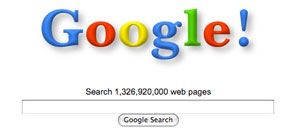What Was Search Like in 2001? Google Knows
 As part of its 10th birthday celebration, Google has dusted off a vintage search index circa 2001 and slapped together a scale replica (as in searching 1.3 billion URLs instead of a trillion) of the old search engine. The Search 2001 site looks like the Google of 7 years ago (which is apparently as far back as they could easily go), including the old logo, and lack of vertical search links.
As part of its 10th birthday celebration, Google has dusted off a vintage search index circa 2001 and slapped together a scale replica (as in searching 1.3 billion URLs instead of a trillion) of the old search engine. The Search 2001 site looks like the Google of 7 years ago (which is apparently as far back as they could easily go), including the old logo, and lack of vertical search links.
The real fun is in searching the old index, though. Google’s blog makes some suggestions: “‘iPod‘ did not refer to a music player, ‘youtube‘ was nonsense, and if you were looking for ‘Michael Phelps,’ chances are you meant the scientist, not the swimmer.”
A search for “SitePoint” finds just 2,920 results, as opposed to greater than 1.8 million today, including links to the old forums URL (sitepointforums.com) and mention of a goofy old tagline of ours: “Helping Business Grow Online!”
The Google 2001 search includes links to Internet Archive Wayback Machine versions of the sites in its index, which means you can search and browse like it’s 7 years ago. Do you remember when SitePoint looked like this?
Some other fun searches:
- [ruby on rails] = a type of shelving unit
- [facebook] = rather prophetically, a searchable database of Harvard students
- [segway] = the Science Education Gateway at Berkley
- [firefox] = a personal homepage
- [wii] = Willamette Industries, makers of “superior forest products”
- [android] = a bot for Counter-Strike
- [web 2.0] = for some reason, Netscape.com
What are some other fun searches that you’ve found? Share your favorites in the comments below.
Frequently Asked Questions (FAQs) about Google Search in 2001
How did Google’s search algorithm work in 2001?
In 2001, Google’s search algorithm was primarily based on the PageRank system. This system ranked web pages based on the number and quality of links pointing to them. The more high-quality links a page had, the higher its PageRank score, and the higher it would appear in search results. However, the algorithm was not as sophisticated as it is today, and it was easier for websites to manipulate their rankings through tactics like keyword stuffing and link farming.
What were the most popular search queries on Google in 2001?
In 2001, the most popular search queries on Google were largely influenced by major events and popular culture of the time. For instance, following the September 11 attacks, terms related to the event such as ‘World Trade Center’ and ‘Osama bin Laden’ saw a significant increase in searches. Other popular search terms included ‘Harry Potter’, ‘Lord of the Rings’, and ‘Britney Spears’, reflecting the popularity of these franchises and celebrities during that period.
How has Google’s search interface evolved since 2001?
Since 2001, Google’s search interface has undergone numerous changes to improve user experience. In 2001, the interface was quite basic, with a simple search bar and two buttons for ‘Google Search’ and ‘I’m Feeling Lucky’. Over the years, Google has added features like autocomplete suggestions, voice search, and personalized search results based on user behavior and preferences. The interface has also become more visually appealing, with the introduction of the Google Doodle and a cleaner, more minimalist design.
What were some of the challenges faced by Google in 2001?
In 2001, Google faced several challenges. One of the main challenges was dealing with the rapid growth of the internet and the increasing amount of information available online. This required constant updates and improvements to their search algorithm to ensure relevant and accurate search results. Another challenge was competition from other search engines like Yahoo and MSN, which were also popular at the time.
How did Google handle foreign languages and non-English content in 2001?
In 2001, Google was already making efforts to cater to non-English speakers. The search engine supported multiple languages, and users could choose their preferred language for search results. However, the quality of translations and the ability to understand and index non-English content has significantly improved over the years with advancements in machine learning and natural language processing technologies.
What was the ‘I’m Feeling Lucky’ button on Google’s 2001 search page?
The ‘I’m Feeling Lucky’ button was a feature on Google’s search page that would take users directly to the first search result for their query, bypassing the search results page. This feature was designed to help users save time and get to their desired content more quickly. However, with the evolution of Google’s search algorithm and the introduction of features like autocomplete suggestions, the ‘I’m Feeling Lucky’ button has become less prominent.
How did Google’s ad system work in 2001?
In 2001, Google’s ad system was still in its early stages. The company had just launched AdWords, a platform that allowed advertisers to create text ads that would appear alongside search results. Advertisers would bid on keywords, and the ads would be displayed based on the relevance of the ad to the search query and the amount bid by the advertiser.
How did Google handle privacy and user data in 2001?
In 2001, Google’s approach to privacy and user data was much simpler than it is today. The company collected basic information like search queries and IP addresses to improve its services and provide more relevant search results. However, as Google’s services have expanded and technology has evolved, the company’s data collection practices have become more complex, leading to ongoing debates about privacy and data protection.
What was the impact of the September 11 attacks on Google’s search trends in 2001?
The September 11 attacks had a significant impact on Google’s search trends in 2001. In the aftermath of the attacks, there was a surge in searches related to the event, including terms like ‘World Trade Center’, ‘Pentagon’, ‘Osama bin Laden’, and ‘terrorism’. This event highlighted the role of search engines in providing information during major global events.
How did Google’s search results display in 2001?
In 2001, Google’s search results were displayed in a simple list format, with each result consisting of a title, URL, and a brief snippet of text from the page. The results were ranked based on their relevance to the search query, as determined by Google’s PageRank algorithm. Over the years, Google has added features like rich snippets, knowledge graphs, and image and video results to provide more comprehensive and useful search results.
Before joining Jilt, Josh Catone was the Executive Director of Editorial Projects at Mashable, the Lead Writer at ReadWriteWeb, Lead Blogger at SitePoint, and the Community Evangelist at DandyID. On the side, Josh enjoys managing his blog The Fluffington Post.
